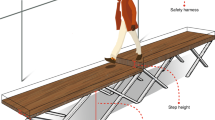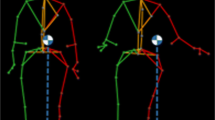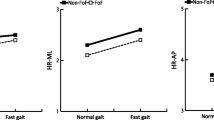Abstract
The fear of falling can be manipulated by introducing a postural threat (e.g., an elevated support surface) during stance and gait. Under these conditions, balance parameters are altered in both young and elderly individuals. This study aimed to dissociate the physical and psychological aspects of the threat and show the impact of a verbal warning cue of imminent perturbation during gait among young and elderly healthy participants. Ten young subjects (29.4 ± 3.9 years) and ten subjects aged over 65 years (72.9 ± 3.5) participated in the study. Spatiotemporal and balance parameters were quantified during eight consecutive gait cycles using a motion analysis system and an instrumented treadmill. These parameters were compared twice in the control trial and before/after a verbal warning cue of imminent perturbation during gait (“postural threat”) in perturbation trials and between groups using repeated measure ANOVAs. Results: The verbal cue yielded reduced step length (p = 0.008), increased step width (p = 0.049), advanced relative position of the center of mass (p = 0.016), increased stabilizing force (p = 0.003), and decreased destabilizing force (p = 0.002). This warning effect was not observed in the older participant group analyses but was found for three participants based on individual data analyses. The warning effect in younger participants was not specific to impending perturbation conditions. Most gait and balance parameters were altered in the older group (p < 0.05) versus the younger group in each condition, regardless of the warning cue. A psychological threat affects gait and balance similarly to a physical threat among young participants but not among most older participants.

Similar content being viewed by others
References
Adkin AL, Frank JS, Carpenter MG, Peysar GW (2000) Postural control is scaled to level of postural threat. Gait Posture 12:87–93
Adkin AL, Frank JS, Carpenter MG, Peysar GW (2002) Fear of falling modifies anticipatory postural control. Exp Brain Res 143:160–170
Adkin AL, Campbell AD, Chua R, Carpenter MG (2008) The influence of postural threat on the cortical response to unpredictable and predictable postural perturbations. Neurosci Lett 435:120–125. doi:10.1016/j.neulet.2008.02.018
Belgen B, Beninato M, Sullivan PE, Narielwalla K (2006) The association of balance capacity and falls self-efficacy with history of falling in community-dwelling people with chronic stroke. Arch Phys Med Rehabil 87:554–561. doi:10.1016/j.apmr.2005.12.027
Bhatt T, Wang TY, Yang F, Pai YC (2013) Adaptation and generalization to opposing perturbations in walking. Neuroscience 246:435–450. doi:10.1016/j.neuroscience.2013.04.013
Bohannon RW (2006) Reference Values for the Five-Repetition sit-to-stand test : a descriptive meta-analysis of data from elders. Percept Mot Skills 103:215–222. doi:10.2466/pms.103.1.215-222
Brown LA, Frank JS (1997) Postural compensations to the potential consequences of instability: Kinematics. Gait Posture 6:89–97 doi:10.1016/S0966-6362%2896%2901106-X
Brown LA, Gage WH, Polych MA, Sleik RJ, Winder TR (2002a) Central set influences on gait. Age-dependent effects of postural threat. Exp Brain Res 145:286–296
Brown LA, Sleik RJ, Polych MA, Gage WH (2002b) Is the prioritization of postural control altered in conditions of postural threat in younger and older adults? J Gerontol Ser A Biol Sci Med Sci 57:M785–M792
Brown LA, Doan JB, McKenzie NC, Cooper SA (2006) Anxiety-mediated gait adaptations reduce errors of obstacle negotiation among younger and older adults: implications for fall risk. Gait Posture 24:418–423
Brown LA, Doan JB, Whishaw IQ, Suchowersky O (2007) Parkinsonian deficits in context-dependent regulation of standing postural control. Neurosci Lett 418:292–297
Buatois S, Miljkovic D, Manckoundia P et al (2008) Five times sit to stand test is a predictor of recurrent falls in healthy community-living subjects aged 65 and older. J Am Geriatr Soc 56:1575–1577. doi:10.1111/j.1532-5415.2008.01777.x
Caetano MJ, Gobbi LT, Sanchez-Arias Mdel R, Stella F, Gobbi S (2009) Effects of postural threat on walking features of Parkinson’s disease patients. Neurosci Lett 452:136–140. doi:10.1016/j.neulet.2009.01.053
Carpenter MG, Frank JS, Silcher CP, Peysar GW (2001) The influence of postural threat on the control of upright stance. Exp Brain Res 138:210–218
Chamberlin ME, Fulwider BD, Sanders SL, Medeiros JM (2005) Does fear of falling influence spatial and temporal gait parameters in elderly persons beyond changes associated with normal aging? J Gerontol Ser A Biol Sci Med Sci 60:1163–1167
Cleworth TW, Horslen BC, Carpenter MG (2012) Influence of real and virtual heights on standing balance. Gait Posture 36:172–176. doi:10.1016/j.gaitpost.2012.02.010
Cumming RG, Salkeld G, Thomas M, Szonyi G (2000) Prospective study of the impact of fear of falling on activities of daily living, SF-36 scores, and nursing home admission. J Gerontol Ser A Biol Sci Med Sci 55:M299–M305
Davis JR, Horslen BC, Nishikawa K, Fukushima K, Chua R, Inglis JT, Carpenter MG (2011) Human proprioceptive adaptations during states of height-induced fear and anxiety. J Neurophysiol 106:3082–3090. doi:10.1152/jn.01030.2010
Delbaere K, Crombez G, Vanderstraeten G, Willems T, Cambier D (2004) Fear-related avoidance of activities, falls and physical frailty. A prospective community-based cohort study. Age Ageing 33:368–373. doi:10.1093/ageing/afh106
Delbaere K, Sturnieks DL, Crombez G, Lord SR (2009) Concern about falls elicits changes in gait parameters in conditions of postural threat in older people. J Gerontol Ser A Biol Sci Med Sci 64:237–242. doi:10.1093/gerona/gln014
Desrosiers E, Nadeau S, Duclos C (2014) Balance during walking on an inclined instrumented pathway following incomplete spinal cord injury. Spinal Cord. doi:10.1038/sc.2014.215
Duclos C, Desjardins P, Nadeau S, Delisle A, Gravel D, Brouwer B, Corriveau H (2009) Destabilizing and stabilizing forces to assess equilibrium during everyday activities. J Biomech 42:379–382. doi:10.1016/j.jbiomech.2008.11.007
Duclos C, Miéville C, Gagnon D, Leclerc C (2012) Dynamic stability requirements during gait and standing exergames on the wii fit® system in the elderly. J NeuroEng Rehabil 9:1–7. doi:10.1186/1743-0003-9-28
Espy DD, Yang F, Bhatt T, Pai YC (2010) Independent influence of gait speed and step length on stability and fall risk. Gait Posture 32:378–382 doi:10.1016/j.gaitpost.2010.06.013
Filiatrault J, Desrosiers J, Trottier L (2009) An exploratory study of individual and environmental correlates of fear of falling among community-dwelling seniors. J Aging Health 21:881–894. doi:10.1177/0898264309340694
Folstein MF, Folstein SE, McHugh PR (1975) “Mini-mental state”: a practical method for grading the cognitive state of patients for the clinician. J Psychiatr Res 12:189–198. doi:10.1016/0022-3956(75)90026-6
Friedman SM, Munoz B, West SK, Rubin GS, Fried LP (2002) Falls and fear of falling: which comes first? A longitudinal prediction model suggests strategies for primary and secondary prevention. J Am Geriatr Soc 50:1329–1335. doi:10.1046/j.1532-5415.2002.50352.x
Fritz CO, Morris PE, Richler JJ (2012) Effect size estimates: current use, calculations, and interpretation. J Exp Psychol Gen 141:2–18. doi:10.1037/a0024338
Hamel D (2001) Évolution des traumatismes au Québec de 1991 à 1999. Institut national de santé publique du Québec, Montréal
Hauck LJ, Carpenter MG, Frank JS (2008) Task-specific measures of balance efficacy, anxiety, and stability and their relationship to clinical balance performance. Gait Posture 27:676–682. doi:10.1016/j.gaitpost.2007.09.002
Horak FB, Wrisley DM, Frank J (2009) The balance evaluation systems test (BESTest) to differentiate balance deficits. Phys Ther 89:484–498. doi:10.2522/ptj.20080071
Horslen BC, Murnaghan CD, Inglis JT, Chua R, Carpenter MG (2013) Effects of postural threat on spinal stretch reflexes: evidence for increased muscle spindle sensitivity? J Neurophysiol 110:899–906. doi:10.1152/jn.00065.2013
Hyndman D, Ashburn A, Stack E (2002) Fall events among people with stroke living in the community : Circumstances of falls and characteristics of fallers. Arch Phys Med Rehabil 83:165–170. doi:10.1053/apmr.2002.28030
Ilmane N, Croteau S, Duclos C (2015) Quantifying dynamic and postural balance difficulty during gait perturbations using stabilizing/destabilizing forces. J Biomech 48:441–448. doi:10.1016/j.jbiomech.2014.12.027
Laufer Y, Barak Y, Chemel I (2006) Age-related differences in the effect of a perceived threat to stability on postural control. J Gerontol Ser A Biol Sci Med Sci 61:500–504
Lelard T, Krystkowiak P, Montalan B et al (2014) Influence of postural threat on postural responses to aversive visual stimuli. Behav Brain Res 266:137–145. doi:10.1016/j.bbr.2014.02.051
Maki BE, Whitelaw RS (1993) Influence of expectation and arousal on center-of-pressure responses to transient postural perturbations. J Vestib Res Equilib Orientat 3:25–39
McKenzie NC, Brown LA (2004) Obstacle negotiation kinematics: age-dependent effects of postural threat. Gait Posture 19:226–234 doi:10.1016/S0966-6362%2803%2900060-2
Mendes de Leon CF, Seeman TE, Baker DI, Richardson ED, Tinetti ME (1996) Self-efficacy, physical decline, and change in functioning in community-living elders: a prospective study. J Gerontol B Psychol Sci Soc Sci 51:S183–S190
Mullie Y, Duclos C (2014) Role of proprioceptive information to control balance during gait in healthy and hemiparetic individuals. Gait Posture 40:610–615. doi:10.1016/j.gaitpost.2014.07.008
Myers AM, Fletcher PC, Myers AH, Sherk W (1998) Discriminative and evaluative properties of the activities-specific balance confidence (ABC) scale. J Gerontol Ser A Biol Sci Med Sci 53A:M287–M294. doi:10.1093/gerona/53A.4.M287
O’Hoski S, Winship B, Herridge L, Agha T, Brooks D, Beauchamp MK, Sibley KM (2014) Increasing the clinical utility of the BESTest, Mini-BESTest, and Brief-BESTest: normative values in canadian adults who are healthy and aged 50 years or older. Phys Ther 94:334–342. doi:10.2522/ptj.20130104
Pasman EP, Murnaghan CD, Bloem BR, Carpenter MG (2011) Balance problems with Parkinson’s disease: are they anxiety-dependent? Neuroscience 177:283–291. doi:10.1016/j.neuroscience.2010.12.050
Pijnappels M, Bobbert MF, van Dieën JH (2001) Changes in walking pattern caused by the possibility of a tripping reaction. Gait Posture 14:11–18. doi:10.1016/S0966-6362(01)00110-2
Powell LE, Myers AM (1995) The Activities-specific Balance Confidence (ABC) Scale. J Gerontol Ser A Biol Sci Med Sci 50A:M28–M34. doi:10.1093/gerona/50A.1.M28
Rossier P, Wade DT (2001) Validity and reliability comparison of 4 mobility measures in patients presenting with neurologic impairment. Arch Phys Med Rehabil 82:9–13. doi:10.1053/apmr.2001.9396
Rubenstein LZ (2006) Falls in older people: epidemiology, risk factors and strategies for prevention. Age Ageing 35:ii37–ii41. doi:10.1093/ageing/afl084
Shaw JA, Stefanyk LE, Frank JS, Jog MS, Adkin AL (2012) Effects of age and pathology on stance modifications in response to increased postural threat. Gait Posture 35:658–661. doi:10.1016/j.gaitpost.2011.12.020
Staab JP, Balaban CD, Furman JM (2013) Threat assessment and locomotion: clinical applications of an integrated model of anxiety and postural control. Semin Neurol 33:297–306. doi:10.1055/s-0033-1356462
Tersteeg MCA, Marple-Horvat DE, Loram ID (2012) Cautious gait in relation to knowledge and vision of height: Is altered visual information the dominant influence? J Neurophysiol 107:2686–2691. doi:10.1152/jn.00875.2011
Tinetti ME, Speechley M (1989) Prevention of falls among the elderly. N Engl J Med 320:1055–1059. doi:10.1056/NEJM198904203201606
Tinetti ME, Doucette J, Claus E, Marottoli R (1995) Risk factors for serious injury during falls by older persons in the community. J Am Geriatr Soc 43:1214–1221
van Schenau I (1980) Some fundamental aspects of the biomechanics of overground versus treadmill locomotion. Med Sci Sports Exerc 12:257–261
Whitney SL, Wrisley DM, Marchetti GF, Gee MA, Redfern MS, Furman JM (2005) Clinical measurement of sit-to-stand performance in people with balance disorders: validity of data for the five-times-sit-to-stand test. Phys Ther 85:1034–1045
Winter DA (2009) Biomechanics and motor control of human movement. Wiley, Hoboken
Zijlstra GAR, Van Haastregt JCM, Van Rossum E, Van Eijk JTM, Yardley L, Kempen GIJM (2007) Interventions to reduce fear of falling in community-living older people: a systematic review. J Am Geriatr Soc 55:603–615. doi:10.1111/j.1532-5415.2007.01148.x
Author information
Authors and Affiliations
Corresponding author
Ethics declarations
Conflict of interest
The authors declare that they have no conflicts of interest.
Ethical approval
All procedures performed in studies involving human participants were in accordance with the ethical standards of the institutional and/or national research committee and with the 1964 Helsinki declaration and its later amendments or comparable ethical standards.
Rights and permissions
About this article
Cite this article
Dubreucq, L., Mereu, A., Blanc, G. et al. Introducing a psychological postural threat alters gait and balance parameters among young participants but not among most older participants. Exp Brain Res 235, 1429–1438 (2017). https://doi.org/10.1007/s00221-017-4902-y
Received:
Accepted:
Published:
Issue Date:
DOI: https://doi.org/10.1007/s00221-017-4902-y




